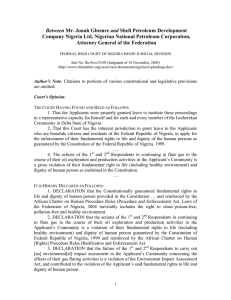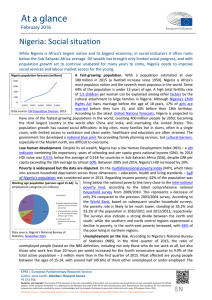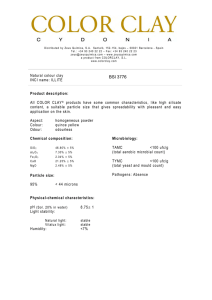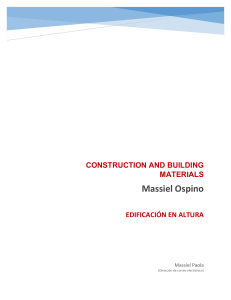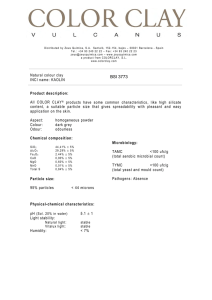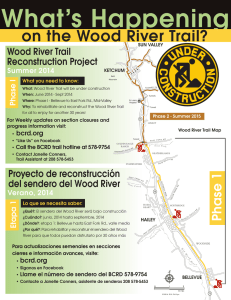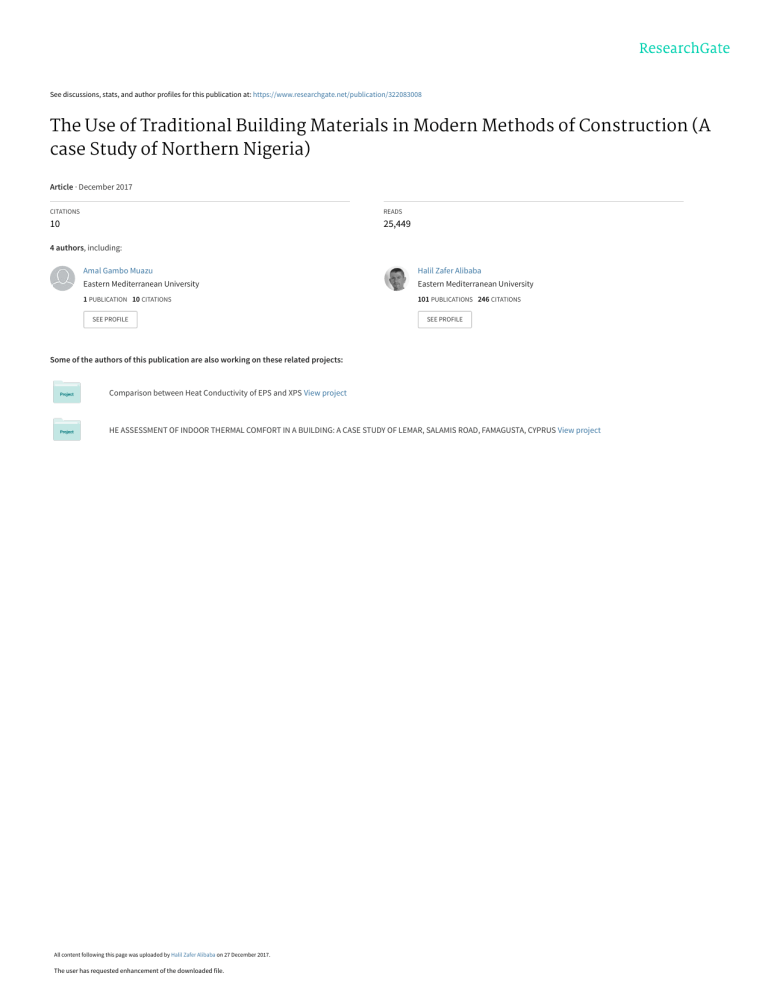
See discussions, stats, and author profiles for this publication at: https://www.researchgate.net/publication/322083008 The Use of Traditional Building Materials in Modern Methods of Construction (A case Study of Northern Nigeria) Article · December 2017 CITATIONS READS 10 25,449 4 authors, including: Amal Gambo Muazu Halil Zafer Alibaba Eastern Mediterranean University Eastern Mediterranean University 1 PUBLICATION 10 CITATIONS 101 PUBLICATIONS 246 CITATIONS SEE PROFILE SEE PROFILE Some of the authors of this publication are also working on these related projects: Comparison between Heat Conductivity of EPS and XPS View project HE ASSESSMENT OF INDOOR THERMAL COMFORT IN A BUILDING: A CASE STUDY OF LEMAR, SALAMIS ROAD, FAMAGUSTA, CYPRUS View project All content following this page was uploaded by Halil Zafer Alibaba on 27 December 2017. The user has requested enhancement of the downloaded file. ISSN: 2456 - 0464 International Journal of Engineering Science Technology And Research (IJESTR) Available Online at: www.ijestr.com Volume – 2, Issue – 6, November – December - 2017, Page No. 30 - 40 The Use of Traditional Building Materials in Modern Methods of Construction (A case Study of Northern Nigeria) Amal Gambo Muazu1, Assoc. Prof. Dr. Halil Zafer Alibaba2 1 Eastern Mediterranean University, School of Architecture, Gazimagusa, North Cyprus E-mail: amalmuazu@gmail.com 2 School of Architecture, Eastern Mediterranean University,Gazimagusa, North Cyprus E-mail: halil.alibaba@gmail.com Abstract In Nigeria, traditional building materials are found in large quantities and varieties, although these materials are dependent upon the geographical location of the area. The most widely used and readily available traditional building materials in Nigeria are adobe, sheep’s wool, clay, bamboo, thatch, stones, timber, coconut tree, and straw bales. These materials have economic advantages compared to the imported and retrofit materials. Sustainable construction is a form of construction that requires knowledge in use of readily available building materials which have low carbon emission and also reusable and recyclable for other functions, and produced on site or nearby area to ease transportation cost. The rise in the cost of constructing houses has remained a major concern for the government in Nigeria because of the over reliance on the use of imported construction materials. Its high time to look into sustainable traditional building materials as an alternative which would act as a catalyst in the reduction of housing cost. Apart from the economic aspects, most traditional building material are known for their thermal properties which would go a long way in reducing the energy cost and issues of thermal comfort in houses. Energy consumption is a critical environmental factor in the construction sector which is a relevant factor in the processing of building materials in the industrialized process. Sustainable design should utilize traditional building materials because of how readily available it is and its renewable properties. However, some of these traditional materials are produced without any form of standardization. This has greatly affected its development in Nigeria. Hence this paper would be looking into how best traditional buildings materials can used in contemporary form of building construction and techniques. At the end of this paper we should be able to determine why traditional building materials has not been accepted into the contemporary construction sector in Nigeria and proper solutions on how traditional building materials can be reinvigorated back into the Nigerian construction sector. Keywords: Traditional building materials, questionnaire survey and modern methods of construction. 1. Introduction Majority of buildings in Northern Nigeria are still constructed using traditional techniques and materials (timber, bamboo). Once again, in the most recent years there has been an increase use of modern techniques for building and shortage of skilled labor. Natural building materials, such as stone, wood, straw, sheep's wool, fibers, hemp, cork and Page clay are examples of the traditional building materials. But, in the last fifteen years, there has been an upturn of interest in 30 development, driven by a range of factors including requests for more rapid construction, the sustainability of construction Correspondinng Author: Amal Gambo Muazu, IJESTR, Volume – 2, Issue – 6, Page No. 30 - 40 Amal Gambo Muazu, et al. International Journal of Engineering Science Technology And Research (IJESTR) natural and unconventional construction materials. Housing is among the most basic human needs, it is a vital component towards a sustainable environmental development. Sustainability has been characterized as a development of the economy that satisfies the needs of the current generation without compromising the opportunity and the potential the future generations. [1] Generally, sustainability is divided into three sectors, which includes economic, environmental, and social sectors, which represent three pillars of sustainable development [2]. In the design world, sustainable construction affects the short and long term economic goals [3]. Traditional building materials cut the cost of the overall construction by an easier construction process, low transportation costs and lower economic demands. Social sustainability focuses on the building users. The occupants need (current and future) to influence the building design, which creates a highly-flexible plan that lets the building to be easily re-purposed as needs change by the design. A structure that can be used for a very long time portrays a flexible design, which prevents the negative impact involved in tearing down an existing building and rebuilding a new one [4]. An increase in the efficient energy use of a building addresses its environmental sustainability, therefore, the structure should be designed in such a way that it utilizes the natural energy for both heating and other energy needed activities. It also entails installing water reduction measures, waste management and using green and local building materials. In relation to site context, the location and orientation of a building can make it more environmentally friendly. According to the three pillars of sustainable development, the main advantages of the use of traditional building materials in modern methods of entails the following: [5] Economic sustainability; entails construction of buildings by modern building methods using traditional materials have less effect and they can be built quickly. A better standard is provided and quality of design and the process of construction can be zoomed up by mass production of prefabricated components in factories or on site. Social sustainability; dwells on the methods and materials that have fewer accidents and less impact on local residents during construction and as well the reduction in labor intensive activities and establishment of a safer working environment. To help reduce unsuccessful work, Architects and contractors from different places can work closely together in the early design stage. Environmental sustainability; entails less transport of materials, and produce lesser amount of waste, for an efficient energy use throughout the life cycle of the building. 1.1 Traditional Materials Available In Nigeria Traditional (natural) building materials can be used as: Structural materials – load bearing construction (wood, stone, rammed earth, straw bales, clay bricks, etc.) Insulation materials – sheep wool, fibers - hemp, cork, etc., Complementary materials – realization of plastering, painting, flooring (clay, cork, etc.). a. Rice hull is used in the production of hollow blocks thereby providing insulation. The raw material is readily available and inexpensive, while the processing equipment can be made locally. [6] b. Hempcrete is a bio-composite made of the inner woody core of the hemp plant mixed with a lime-based binder. It is used mainly for insulating materials in floors, walls and roofs as a high-quality product, containing hemp fibers (85%), fibers 10%, and 5% sodium carbonate, which is added as a fire protection. [7] Page of tiny air pockets that trap air, helping to provide a thermal barrier. It is natural, ecological and renewable. 31 c. Sheep’s wool is used as an insulation material. It is fire resistant, it purifies air and it is sustainable. It forms millions © 2016 IJESTR, All Rights Reserved Amal Gambo Muazu, et al. International Journal of Engineering Science Technology And Research (IJESTR) d. Stone is used for walls, floors, arches and roofs. Building stones possess high strength, durability, thermal mass. It can easily be recycled. e. Bamboo has higher tensile strength than steel because its fibers run axially. It is cost effective and easy to use. It is fire resistant and has low weight. It also has high carbon sequestration capacities. f. Coconut Lumber is best for structural elements like Pillars, window and door frames, floors and decking. g. Clay is the oldest natural building materials. It consists of a mixture of clay, sand, and dust. It may also contain coarser particles (gravel) or organic material. The most common way to use clay in the construction is in the form of clay bricks or clay in the form of ramming. In addition, it presents the filling of half-timbered construction and wood framed construction or as a clay plaster. [8] h. Straw occurs in the form of straw bales which are then used either as infill cladding for wood framed buildings or as load-bearing construction. [9] Each of this traditional construction material is characterized by physical properties that determine its use in construction sector (Tab.1). The natural materials are the most common use as thermal insulating material. Natural material Density ρ [kg/m3] Coefficient of thermal Usage conductivity λ [W/(mK)] Hempcrete 90-180 0.44-0.063 Insulation of floor, roof and fiber composites Sheep’s wool 15-25 0.056-0.03 Insulation of walls, floors, roof and infill cladding for wood framed buildings Bamboo 90-180 0.044-0.065 For load bearing constructions- roofing, infill cladding for wood framed buildings Clay 1000-2200 0.20-0.95 Infill cladding for wood framed buildings, clay plasters Straw 90-100 0.044-0.063 Load bearing construction, roofing Table 1: Properties and usage of natural materials 1.2 Traditional Materials in Modern Building Systems The new technique of construction involves the production of building materials on site (cast in situ) or in factories (precast), that has possible benefits like fewer housing defects, decrease in energy use and waste, fast rate of construction and a higher possibility to minimize waste coming from the construction process. [10] This new technique of construction is frequently used in building construction process but appear less in civil engineering. Most at times civil engineering projects, use modern method of construction that tend to include the use of preassembled components or pre-cast components.The financial demands of the use of traditional building materials in Nigeria require very little amount of Page 32 capital as a result of the proximity and availability of the material to the construction site and also the know-how of the © 2016 IJESTR, All Rights Reserved Amal Gambo Muazu, et al. International Journal of Engineering Science Technology And Research (IJESTR) local work force on the materials. Hempcrete, cob, earthbags, straw bale construction etc. are some of the frequently used natural building techniques. Raw earth is an abundant resource in several rural areas in Nigeria, and as a result it became a popular building material [11]. Recently, modern technologies have renovated the use of raw earth materials to enhance its workability. Compressed earth blocks made of a semi dry mix of clay and sand and produced using a mechanized hydraulically compressed block machine are created from raw earth materials. One of the notable improvement observed in these blocks is its load bearing capacity that is two-third that of concrete masonry blocks. Another improvement of this earth material is achieved by adding little percentage of cement during the cause of production in order to produce compressed and stabilized earth blocks. The comprehensive strength of the block is better and its water resistance, and provide the platform for thinner and higher walls to be built. The energy requirement of stabilized compressed raw earth blocks is 3-5 times lower than the conventional fired blocks. [12] Hempcrete has an extraordinary thermal property. The pocket of air trapped within the material provides insulation; both in the spaces between particles of hemp shiv, and in microscopic pores in the hemp shiv itself. Hempcrete provides thermal mass, as well as insulation, due to density of the lime binder once it has set [7]. These points to the fact that hempcrete can store heat inside the fabric of the material itself, as such it differs from lightweight insulation that only has the ability to store heat within the trapped air inside the material. The ability of hempcrete to store heat in this way as well as insulating has two important advantages. Figure 2A and B: Thermal insulation by Hempcrete panels and prefabricated Hempcrete panels [7] The natural construction material which is frequently use is wood which can be applied to heavy framed, light framed or log construction. The most popular types of building methods for wood are light wood framed construction in Northern Nigeria buildings. We are familiar with the method of construction where the wood presents load-bearing construction and other natural materials (straw bales can) presents infill cladding [13]. Wood can be used in various ways of construction, with the major difference coming in level of prefabrication. Therefore, it becomes relevant to comprehend the relationship between prefabrication, construction time, moisture content of the material and the need for climate protection, as related to the choice of wood material and production method. High-rise buildings with seven or more floors, sports halls, car parks are structures that are not usually associated with wood construction. Nevertheless, wood has Page 33 become a frequently used structural material in the construction of several buildings in Nigeria. © 2016 IJESTR, All Rights Reserved Amal Gambo Muazu, et al. International Journal of Engineering Science Technology And Research (IJESTR) Figure 3A and B: wood construction as load bearing [13] 2. Research Materials and Methodology Natural building materials are used by modern methods of construction because they have lower embodied energy than conventional materials and they increase the usage of renewable and recyclable materials. The aim of this paper is to find out the potential use of traditional building materials in modern methods of constructions. The research was realized through the questionnaire survey. A questionnaire was developed and administered to 50 respondents – architects, engineers and contractors in Nigeria. It was completed in 5 days in November,2017. The questionnaire, consisting of 8 questions, was designed to address the identification of respondents’ awareness about the traditional building materials and systems usage in Northern Nigeria and determining the drivers and barriers of using natural (traditional building materials) in Nigeria. In the questionnaire, the people that answered the questions were requested to answer the most suitable answer on a scale of 1-5 from the highest level to the lowest level. - Strongly agree was given as 1 - Agree was assigned as 2 - Neural was given as 3 - Disagree was assigned to 4 - Strongly disagree was assigned to 5 IBM SPSS Software was used to determine the percentage and mean of the respondent’s answers to the questions in the questionnaire survey. Details of the analysis and results are explained in findings and discussions below. 2.1 Emir’s Palace in Katsina The palace is located in Katsina which is in the Northern part of Nigeria. Due to its unique ornaments and bright colors, it is a tourist attraction. People from different places visit the palace visit the palace. It was constructed when traditional building materials were the only construction materials available in Nigeria. The palace is made of sundried clay bricks mud and rafters with high quality clay mixed with cow dung used as plaster. The materials used in the building have made it possible to withstand harsh weather for many centuries. The building is more than a hundred years old and it Page 34 has thermal insulation. © 2016 IJESTR, All Rights Reserved Amal Gambo Muazu, et al. International Journal of Engineering Science Technology And Research (IJESTR) Figure 4 [14] Figure 5A and B [14] 2.2. Emir’s Palace in Kano The palace was constructed in 1963. The Kano Royal Palace or the Emir’s Palace, is a masterpiece of Hausa architecture, symbolizing the culture, history and tradition of Kanawa. Figure 5A and B Source: www.nigeriagalleria.com/Nigeria/States A mixture of red soil, colorants obtained from the empty pod of locust bean tree and loda, a plant fluid extracted after Page 35 pounding the leaves was used to adorn the outer walls and the interior of the rooms with beautiful artistic designs. [10] © 2016 IJESTR, All Rights Reserved Amal Gambo Muazu, et al. International Journal of Engineering Science Technology And Research (IJESTR) Figure 6A and B Source:www.nigeriagalleria.com/Nigeria/States 3. Results and Discussions Questionnaire survey was attended by 50 people for construction of houses. Almost 73% of respondents prefer to build a house with conventional construction materials (ceramic blocks, porous concrete blocks compared to natural materials (hempcrete, bamboo, clay, etc.). Figure 7: Material preferences of respondents I assumed that the lack of interest in the use of traditional building materials by the people is based on lack of knowledge and information about them. The result of the questionnaire confirmed my assumptions. Figure 8: respondent’s awareness about the use of natural materials available in Nigeria The best know traditional material in Nigeria is wood as well as wooden construction (52%). Sheep’s wool and clay are Page sheep’s wool is mostly used for insulation than hempcrete. The respondent’s response from the questionnaire survey 36 available too while the least available material is hempcrete because it is imported from other countries. As a result, © 2016 IJESTR, All Rights Reserved Amal Gambo Muazu, et al. International Journal of Engineering Science Technology And Research (IJESTR) was based on the cost of materials, availability in Nigeria, skilled workers that can work with natural materials, and the availability of conventional materials. Figure 9: respondent’s awareness about the cost of traditional materials over conventional materials According to the respondents, 65% agree that traditional materials are cheaper than conventional materials while 27% did not agree. Traditional materials are available in Nigeria and they are cheap, therefore the use of them in modern methods of construction res Figure 10: Factor of respondents’ awareness about skilled workers There are skilled workers/laborer’s that can use traditional building materials in construction as agreed by 59% of the respondents. Skilled workers in Nigeria is relatively cheap and readily available. However, because of the continuous use of conventional materials, not all skilled workers know how to use traditional materials. Figure 11: Factor of respondents’ awareness on the availability of traditional materials Traditional materials like timber, clay, straw bales are readily available in Nigeria. However, 14% did not agree because Page Nigeria. 37 they are not interested in using them. Conventional materials are expensive but they are available in most parts of © 2016 IJESTR, All Rights Reserved Amal Gambo Muazu, et al. International Journal of Engineering Science Technology And Research (IJESTR) Figure 12: Factor of respondents’ awareness on the availability of conventional materials Conventional materials are available in Northern Nigeria and 46% of the respondents prefer the use of conventional materials over traditional materials because they are satisfied with their properties and they don’t want to try new materials and methods of construction. 33% of the respondents agree that traditional materials like wood, clay, bamboo are better in terms of thermal comfort, insulation and easy construction. The most significant barrier to using traditional materials by modern methods of construction belong availability of conventional building materials and continuous development of new construction technologies and materials. The conventional building materials are widespread at the construction market in Nigeria. Builders are satisfied with their properties and producers are constantly trying to develop new and better conventional building materials to make more money for their business. This is closely related to public attitude to use of natural materials. Builders still do not prefer the sustainable natural construction materials but proven known methods and technologies. The construction market is not bordered to improve the construction skills and professionals using the traditional materials by modern methods of construction. Natural building materials have good thermal insulation properties. The most important factor for respondents is the duration of the overall construction. However, application of traditional materials by modern methods of construction enables reduction of the overall construction time. The last part of the questionnaire survey focused on determining the drivers and barriers of using traditional materials by modern methods of construction. Based on the respondent’s answers, the table below explains the drivers and barriers. Ranking Drivers Barriers 1 Cost of construction Availability of conventional materials (concrete, steel) 2 Availability of technology Public attitude 3 Duration of the overall construction Lack of construction professionals 4 The quality of construction materials Rapid development of new construction and technology materials and technologies 5 Insulation properties of natural Lack of natural construction skills Page Table 2: Ranking of drivers and barriers of using traditional materials by modern methods of construction [5] 38 materials © 2016 IJESTR, All Rights Reserved Amal Gambo Muazu, et al. International Journal of Engineering Science Technology And Research (IJESTR) Conclusion Sustainable construction targets to meet housing needs, infrastructure and conducive working environment without risking the ability of future generation to cater for their own necessities when the time arrives. Sustainable construction includes the economic efficiency, social responsibilities, and environmental performances which contribute to the architectural quality and technical innovation. Traditional building materials are sustainable, renewable cheap and available everywhere. Use of these materials in new construction techniques will enhance energy efficiency in sustainability and reduce the construction cost. The modernization and Innovation implemented to meet current building standards and living conditions are posing a threat to make the traditional building material perish. Nevertheless, sustainable and green building movement provides the traditional materials to be used as a result of locally accessible resources/materials that match the need local condition in a cost-effective manner. Most traditional buildings in Nigeria were constructed with natural materials that are complex and sometimes not compatible with modern materials used today in the construction industry. Some of the factors that add interest to a building and increase its importance are craftsmanship and building materials. Prior to the commencement of the construction, the craftsmen must have a full understanding on the materials and methods they are going to use in the building.In modern Nigerian Architecture, traditional building materials play an important role; mostly in family houses and to a lesser extent in public buildings, as well as some examples of agricultural buildings. The extent to which they are used can be explained by people's demands for high quality materials. Housing holds a significant role in terms of necessities than education and health in developing countries like Nigeria. As such the possession of a house in Nigeria is held with higher value than in advance industrialized countries. In developing countries like Nigeria, when a family doesn’t have a home they call their own, that family is viewed as a very poor family. The provision of affordable housing for many citizens is still the principal focus of the government in Nigeria. Traditional building materials can be combined with conventional materials in modern construction to add their strength and durability.The aim of this paper was the based on the questionnaire survey to define the use of traditional building materials in modern methods of construction. The respondents of questionnaire survey determined the drivers and barriers of traditional materials by using modern methods of construction and assess the public interest in natural building material usage. The use of traditional construction material is one of the sustainable ways of construction rather than the use of new methods of construction. The study revealed that the availability and affordability of traditional materials, renewability, energy efficiency, biodegradability and many more are the main advantages of traditional building materials. Similarly, durability, deforestation, acceptability, low strength, maintenance and other issues were discovered to be the major problems of using traditional materials. References [1]. World Commission on Environment and Development (WCED). (1987). Our common future. Oxford University Press. [2]. Tazikova A. (2014). Sustainability of existing buildings obtained by reconstruction. In Innovative approaches to the Page [3]. Keiner M. (2005). History, definition(s) and models of sustainable development. ETH Zurich 39 design and management of buildings reconstruction, Kosice: TUKE © 2016 IJESTR, All Rights Reserved Amal Gambo Muazu, et al. International Journal of Engineering Science Technology And Research (IJESTR) [4]. Akeju, A. (2007). Challenges to providing affordable housing in Nigeria, Paper presented at the 2nd emerging urban Africa international conference on urban housing finance in Nigeria, held at shehu yar’adua centre Abuja, October 17-19, 2007. [5]. Marcela Spišáková, Daniela Mačková, The Use Potential of Traditional Building Materials for the Realization of Structures by Modern Methods of Construction. SSP - JOURNAL OF CIVIL ENGINEERING Vol. 10, Issue 2, 2015 [6]. https://en.wikipedia.org/wiki/Rice_hulls [7]. http://www.americanlimetechnology.com/what-is-hempcrete/ [8]. www.sustainablematerials.org.uk/resource/clay.html [9]. http://www.strawbalecentral.com/techniques3.html [10]. Modern methods of house building. (2003). Postnote, London [11]. Prof. Ikechukwu Onyegiri and Iwuagwu Ben Ugochukwu, Traditional Building Materials as a Sustainable Resource and Material for Low Cost Housing in Nigeria: Advantages, Challenges and the Way Forward. Int'l Journal of Research in Chemical, Metallurgical and Civil Engg. (IJRCMCE), 2016. [12]. Auroville Earth Institute (2009). Earth Based Technologies. [Online]: www.earth- auroville.com/maintenance/uploaded_pics/4-cseb-en.pdf. [13]. http://tiltconstructionlimited.com/images/project/Benin/wk6/wk6-2.jp. Page 40 [14]. www.nigeriagalleria.com/Nigeria/States © 2016 IJESTR, All Rights Reserved View publication stats
